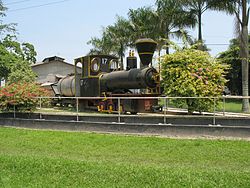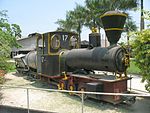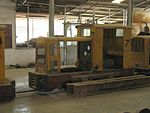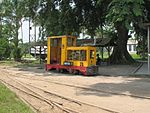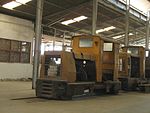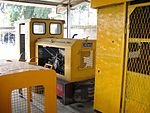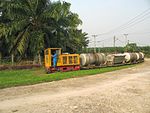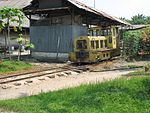Bakrie Sumatera Plantations
| Bakrie Sumatera Plantations | |
|---|---|
| Gauge : | 600 and 1067 mm |
PT. Bakrie Sumatera Plantations Tbk (BSP) - also known as Bakrie Sumatra Plantations Tbk - is the name of an agricultural subsidiary of the Bakrie Group based in Lampung , Indonesia .
The rubber and palm oil factory there operates a narrow-gauge factory railway near Kisaran . The plants are located three kilometers north of Kisaran and directly south-west at the small town of Bunut, located in the subdistrict Kota Kisaran Barat (kecamatan) in the administrative district of Asahan , a geographically central administrative district of the Indonesian province of North Sumatra , which in turn in the northern part of the island of Sumatra lies. Kisaran is the administrative center of Asahan Governorate.
history
BSP is one of the oldest plantation companies and opened its first rubber plantation near Kisaran in 1911 as NV Hollandsch Amerikaanse Plantage Maatschappij . Towards the end of the 1910s, the company belonged to the American United States Rubber Plantation Inc, Sumatra , a subsidiary of the United States Rubber Company (USRC), United States . The plant changed its name to Uniroyal Sumatra Plantations Inc, Kisaran in 1967 and remained a subsidiary of Uniroyal Inc., United States of America. In 1985, the site was put up for sale along with others when the factory was no longer considered part of the company's strategic direction, a year after the parent company also gave up its rubber plantations in Malaysia (Uniroyal Malaysian Plantations Sdn).
In 1986 the Bakrie Group bought this plant and initially operated it under the name PT United Sumatera Plantations . In 1990 the name of the company changed again to PT Bakrie Sumatera Plantations (abbreviated BSP or UNSP - the trading code on the Jakarta Stock Exchange). In 1992 the company began converting parts of the rubber plantations in Kisaran into palm oil plantations. In 1990, BSP opened another palm oil plantation, PT Bakrie Pasaman Plantation, in Pasaman, West Sumatra, and one year later took over the Bah Jambi palm oil factory from PT Agrowiana.
Infrastructure
By 1919 the USRC Sumatran Plantations were the largest rubber plantations in the world. In the 1920s, the development of natural rubber cultivation was influenced by volatile demand, the rise in production costs, the increasing use of synthetic rubber, overproduction and the subsequent Great Depression. Today the Bakrie Sumatera Plantations has around 100,000 hectares of rubber and palm oil plantations under management. BSP owns extensive land. The decision to invest in the palm oil industry was based on the fact that palm oil is more abundant than other raw materials grown on plantations. It should have a higher adaptability to climatic changes.
The plant in Kisaran uses its field railroad to transport the raw product from the plantation to the factory and is therefore probably the last railroad of its kind in Sumatra in the region, along with other field railways on palm oil plantations in Sumatra. Usually two trains leave the factory premises around noon and return from the plantation between 4 and 5 a.m. A third machine helps with the weighing and shunting of the trains in the plant. The Cape-gauge connection to the PTKA state railway was also still in operation.
Those parts of the plantation that were converted for the cultivation of palm oil were only served by trucks from the start.
vehicles
Early known deliveries to this location were a triple-coupled tank locomotive from Vulcan Iron Works (VIW) (serial number 2661 / built in 1917), two also triple-coupled tank locomotives from Davenport (1816/1920 and 1817/2020), delivered to the United States Rubber Plantation Inc, Sumatra in 610 mm gauge, as well as two triple-coupled tank locomotives from Orenstein & Koppel (11894/1929 and 11765/1928) - again in 610 mm gauge (according to the delivery list) - and the triple-coupled Orenstein & Koppel, which has been preserved as a monument to this day ( 7067/1920/40 hp). This 600 mm gauge went to Cultuur Mij, Indragini Uniroyal Kisaran .
Sightings July 2008
Dieselification began in the early 1950s with around ten machines from the English Ruston Hornsby. These locomotives were scrapped around 2006. A second batch of deliveries was provided by the German suppliers Schöma and Diema . One of these machines was designed in Cape gauge (1067 mm) to serve the connection to the PT Kereta Api Indonesia (Persero) state railway on its route from Tebing Tinggi to Kisaran . This cape gauge line leaves the company premises in a north-westerly direction. The light railroad with a 600 millimeter gauge leads from the southeast corner of the factory premises to the plantation and turns south, where it crosses the state railway line about a kilometer away.
Web links
Individual evidence
- ↑ PT. Bakrie Sumatera Plantations tbk - Background ( Memento of the original from February 2, 2017 in the Internet Archive ) Info: The archive link was automatically inserted and has not yet been checked. Please check the original and archive link according to the instructions and then remove this notice. (English)
- ↑ Shakila Yacob: The Impact of the New Economic Policy on US Foreign Direct Investment in Malaysia, IEHC 2006 XIV International Economic History Congress (English)
- ↑ The Business Watch Indonesia: BIOFUEL INDUSTRY IN INDONESIA (English)
- ↑ PT Bakrie Sumatera Plantations TBK | Member | RSPO - Roundtable on Sustainable Palm Oil . rspo.org. Accessed May 30, 2016. (English)
- ↑ Helena Varkkey: The Haze Problem in Southeast Asia (Abingdon: Routledge, 2015), p. 77 (English).
- ↑ Indonesia News - EMBASSY OF THE REPUBLIC OF INDONESIA IN ANKARA, TURKEY, Volume IV October 2007 ( page no longer available , search in web archives ) Info: The link was automatically marked as broken. Please check the link according to the instructions and then remove this notice.
- ↑ Syahri Wahyu Hidayat, Lori Perkebunan Karet (Muntik) PT.BSP Kisaran, Sumatera Utara (English)
- ↑ Syahri Wahyu Hidayat, Lori angkutan perkebunan karet / lateks di Desa Sidodadi, Sumatera Utara
- ↑ Syahri Wahyu Hidayat, Lori Schöma - SCHOEMA No.15 PT. BSP (Bakrie Sumatera Plantation) Kisaran, Sumatera Utara, Indonesia (English)
- ↑ Delivery lists, CD, by Jens Merte, Netphen, Germany
- ↑ Kunio Furukawa "Without Steam Through Indonesia (II)" in Bahn-Express - Magazin für Werkbahnfreunde No. 75, 2/1997, p. 194
Coordinates: 3 ° 0 ′ 10 ″ N , 99 ° 36 ′ 6.5 ″ E
